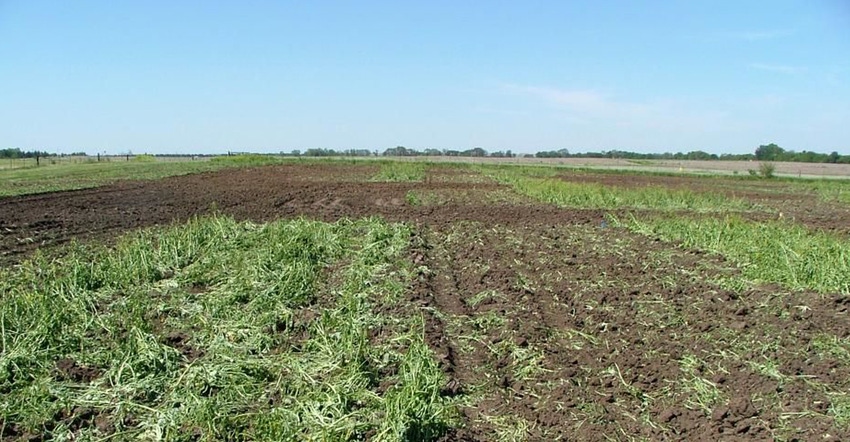
Cover crops may contribute to weed suppression and soil fertility, potentially increasing crop yield and sustainability of the system. Individual cover crop species have been studied for decades, but the potential agronomic benefits of diverse cover crop mixtures have received less attention. Cover crop mixtures are an appealing option for farmers because diverse plant communities in nature have been shown to use soil and light resources more efficiently and produce more biomass. In addition, little is known about the effects of a cover crop termination method on subsequent soil properties and crop performance.
Two experiments were conducted in 2009, 2010 and 2011 at the University of Nebraska-Lincoln Agricultural Research and Development Center (ARDC) near Mead. The goals were to quantify the productivity and agronomic effects of diverse cover crop mixtures and determine whether or not the termination method alters those effects.
Cover crop species included hairy vetch, Idagold mustard, field pea, Pacific Gold mustard, oilseed radish, crimson clover, Dwarf Essex rape and chickling vetch. Species were planted in late March alone in monoculture (Experiment 1) or in a mixture of legume and mustard families ranging from two to eight species (Experiments 1-2). Cover crops were terminated in late May with either a field disk (conventional) or sweep plow undercutter (conservation), and grain crops were planted within one week (Experiment 2). Data collected included soil moisture and nitrogen, weed density and biomass, cover crop biomass, and crop yield. The results provided the following answers:
Do cover crops produce more biomass when planted in mixtures? Cover crops in the mustard family produced nearly twice as much aboveground biomass each spring than those in the legume family. Mixtures were more productive than monoculture cover crops, but total biomass of the mixtures did not change when adding more species to the mixture. Mustard biomass per plant typically increased when planted in a mixture (compared to monoculture), but the opposite was true for legumes. Reduced productivity of legumes in a mixture was largely attributed to the competition for light with the taller species in the mustard family. Therefore, legumes should be planted in monoculture or at much higher proportions in mixtures if nitrogen fixation is a primary management goal for the cover crop planting.
Do cover crop mixture diversity and termination method influence weeds, soil and yield? Weed suppression was variable among the different cover crop mixtures, but this variability could not be explained by diversity or biomass of the mixture. In addition, cover crops were only effective in suppressing weeds if terminated via sweep plow undercutter. With this method, the majority of cover crop residue was left fully intact on the surface with limited soil mixing or inversion. In contrast, disk incorporation of cover crop residues left limited residue on the surface, and soil mixing and surface inversion likely contributed to increased weed seed germination and growth. Cover crop termination via undercutter provided additional agronomic benefits including increased soil moisture and nitrogen availability. Incorporation of cover crops via disk can lead to increased evaporative loss of soil water and immobilization of soil nitrogen as residues more rapidly decompose. Cover crop mixture diversity did not influence crop yield, but terminating any cover crop mixture via undercutter increased corn and soybean yield by 17% and 23%, respectively, compared to the plots without a cover crop control. The negative agronomic consequences of cover crop termination via disk reduced soybean yield by 14% compared to the no cover crop control.
What is the best cover crop or cover crop mixture, and what is the best way to kill it? The ideal cover crop species or mixture will always depend on the specific management objectives for an individual farmer. However, results from this project demonstrate that many cover crop species and combination of species in mixture provide very similar agronomic benefits, and farmers should be encouraged to choose the least-expensive cover crop option (unless nitrogen fixation is the primary management objective).
This project also demonstrates the importance of cover crop residue management. Nearly all potential agronomic benefits of cover crops disappeared when residues were incorporated via disk, but termination via undercutter contributed to increased crop yield. Whenever possible, cover crop residues should be left intact on the soil surface. This can be achieved via herbicides, sweep plow undercutter, roller-crimping or mowing (flail or sickle-bar). Beyond the agronomic benefits measured in this study, planting diverse cover crop mixtures and managing the terminated residues on the soil surface may contribute to increased diversity of beneficial insects and reduced soil erosion.
Wortman is an assistant professor of agronomy, and Francis, Drijber and Lindquist are professors of agronomy at the University of Nebraska-Lincoln. This article was compiled from one of several briefs on cover crop research featured in CropWatch.
About the Author(s)
You May Also Like




